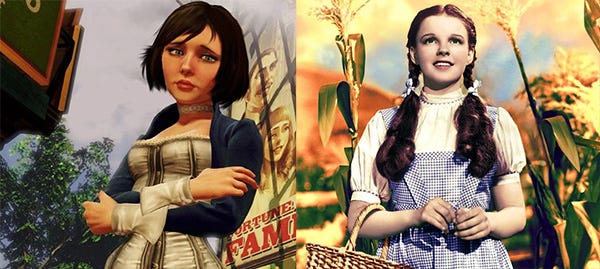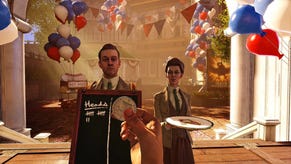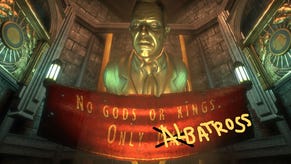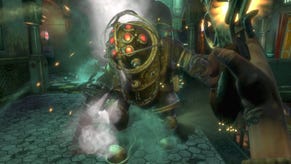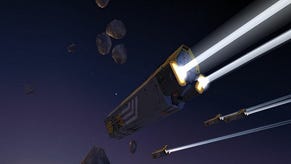The Vigor Of Oz: Bishock Infinite's Wizardly Parallels
The scary crow, the tin soldier and the cowardly lion
The following theory is not true, but it could be. It's surely no accident that BioShock Infinite often evokes The Wizard of Oz - there's even an early stage of the game named after it. Even so, the similarities, be they deliberate or coincidental, run deeper than a turn-of-the-century character being mysteriously transported to an amazing world of technology and magic. Once I started down the yellow brick road of looking for parallels between Dorothy's adventure in Oz and Booker's adventure in Columbia, I couldn't stop - I identified what seemed to be dozens of them. Am I onto something, or am I projecting? It doesn't matter - this is purely a thought experiment, not a claim to accuracy, and I'm entirely sure you could achieve a similar effect by comparing Binfinite to Star Wars or the Bible or Peppa Pig. I'm doing this for fun. Mostly.
Also, SPOILERS UNBOUND. Do not read past this point if you haven't completed the game. (Or if you somehow haven't seen/read The Wizard of Oz). If you have, fire up Dark Side of the Moon and let's go off to see the wizard.
As I say, the major and entirely obvious parallel between Irrational's game and the L. Frank Baum book / Victor Fleming movie is the concept of the lead character being uprooted from early 20th century America and dragged through the sky to a fantastical place. Then again, time period aside, that's hardly unfamiliar territory for videogames. It was when playing the game for a second time (in 1999 mode, but that's another story) that I began to pick up on further apparent similarities.
Last warning: spoilers ahead, and until the end of this piece.
My first trigger for this was Captain Cornelius Slate, the Shock Jockey-wielding army man holed up in the Hall of Heroes level. Amidst the rhetoric he bellows at you throughout your battles with his soldiers and browsing of acutely racist museum exhibits is an oft-repeated refrain - "tin soldiers." In the game's narrative, this relates to his desire for his men and women to not become slavish conscripts of Comstock (who also staffs his forces with literal tin soldiers, the Iron Patriots), their military deeds obscured by his lies, and instead embrace heroic death in battle with Booker. It's no great stretch to interpret tin soldier as Tin Man, the metal woodsman who sought a heart when he joined Dorothy in her adventure along the Yellow Brick Road.
Tin Man imagery abounds throughout the game, in fact - the aforementioned Iron Patriots, but also the tragic Handymen, flesh and blood transposed into hulking metallic form. The Handymen even sport pulsating, glowing 'hearts', the Tin Man's fondest desire, and it's these you should shoot in order to rapidly end these unhappy souls' Frankensteinian unlives. As well as fearing transformation into another of Comstock's tin soldiers, Slate too wants a heart - to die feeling proud and beloved by his troops. He seeks to meet his end at the hands of a real soldier, not servile and brainwashed by a liar. Thus, choosing to kill rather than spare him is the 'right' decision, else he winds up lobotomised and tragic in Fink's dungeons. Have a heart, and grant the old bully the release he so craves.
If we take Slate to be the Tin Man, what of Dorothy's other two companions, the Scarecrow and the Cowardly Lion? This line of thinking is where I switched from feeling silly to slightly startled. We/Booker face three major male 'bosses' before the later, more climactic triumvirate of Daisy Fitzroy, Lady Comstock and Father Comstock. Slate/the Tin Man is the second; before that we have the Fraternal Order of the Raven and their apparently unnamed leader. After Slate is that amoral man of industry/slavery, Jeremiah Fink.
The Fraternal Order of the Raven, also known as Zealots of the Lady, don't really address the player as do Slate and Fink, rendering it difficult to tell if the apparent leader we battle at the climax of our journey through their decay-riddled, bird-infested frathouse is any different to the Zealots, or Crows, we face irregularly throughout the rest of the game. However, an Audio diary found in their headquarters was recorded by the otherwise unmentioned and unseen First Zealot, so I'm going to work on the assumption that the setpiece nature of the first bird-summoning foe we face, and the one whose death grants Booker the Murder of Crows vigor, is said First Zealot. He's a scary Crow. He's the Scarecrow, the first of Dorothy's companions.
I'm probably being over-literal here, but the Order of the Raven's deathly hallow is one of very few sequences in the otherwise colourful and fantastical Binfinite where it attempts open horror. Their manor is filled with rotting fruit, flayed bodies and lurking ravens, while the First Zealot's appearance is preceded by the sight of a man being torn to pieces by crows, popping up unexpectedly to cause a start. The Zealot himself can appear out of nowhere, and wears a coffin strapped to his back. Scare-Crow indeed: but what of the brain Dorothy's Scarecrow so desired? Here I have to reach, but the Zealots' hero is John Wilkes Booth, Abraham Lincoln's assassin. Booth shot Lincoln in the head - point-blank in the brain - in the hope that the great emancipator's death would help defend the racial purity that he - and the Zealots' - so desired. The Scarecrow wants a brain, so he idolises the man who took Lincoln's.
Following the order in which Dorothy meets her companions, we rather neatly get First Zealot as Scarecrow, Slate as Tin Man and finally Fink as the cowardly Lion. Jeremiah Fink is Columbia's captain of industry, and he sure is cowardly even by the standards of such a cruel, bullying society. He flees from Booker in their earliest encounter, at The Raffle (itself a deeply cowardly event which exists purely to demean and abuse Columbia's ethnic minorities), and later encounters have him only ever addressing us by radio from afar, hiding unseen in some safe place. Meanwhile, he flies Comstock's colours but does so purely from cynical financial opportunity, not belief. He even attempts to recruit Booker to his side, as head of security, rather than have to face him - and sends legions of men to die in his stead in order to achieve this.
His final appearance, slain by Daisy Fitzroy (herself guilty of a cowardly act against an unarmed man and, after that, a child), is behind bullet-proof glass, once again out of Booker's reach. Later, we learn that he also arranged the assassination of the Lutece twins, and doubtless numerous others too. He's a damned coward, in every respect - remotely destroying the lives of others, profiting from poverty and misery, having those who try to rise up tortured or killed, while forever keeping out of harm's way himself, protected by hired thugs.
And what of the lion? Just listen to Fink's canned propaganda and rhetoric during our first arrival in Finkton, as black and Irish workers miserably, rhythmically perform their slavelike construction duty for him. They, he says, are Cattle, while natural born leaders like him are Lions. Like Slate and tin soldiers, this is an oft-repeated refrain. As for the bravery the Cowardly Lion sought, perhaps that's Fink's fatal encounter with the living avatar of everything he sought to oppress. Finally, after all that cowardice, he comes face to face with his victims, his crimes. Daisy Fitzroy shoots him in the heart, forever pinning a medal of blood to his breast. His death also presages what could be argued to be the game's bravest act, Elizabeth's endangerment of her own life and sacrifice of her innocence to save a child by slaying Fitzroy.
The scary crow, the tin soldier, the oh-so-cowardly lion. Encountered in Dorothy's order, all of them clearly proclaiming the imagery of their Ozian analogues. They may not be companion figures, but Slate and Fink at least both make some claim to being Booker/Dorothy's friend, while all three inadvertently aid him/her with either Vigors or progress upon their defeat. Coincidence? The truth of it doesn't matter: if the cap fits...
There's another trio in the Wizard of Oz, of course, and they too have eerie parallels in Columbia. The Wicked Witch of the East, the Wicked Witch of the West and the Good Witch of the North - the three powerful women of Oz. In BioShock Infinite, we have Lady Comstock, Daisy Fitzroy and Elizabeth/Anna DeWitt. The Wicked Witch of the East dies essentially off-camera near the start of the Wizard of Oz, and so it is that Lady Comstock had been murdered some time before we/Booker arrives on Columbia. (She later reappears as a ghost, of course, although we learn that this isn't really Lady Comstock as such, but instead a conjuration of Elizabeth's guilt and anger. The good witch, so closely related to, and responsible for, the wicked ones).
Whether Lady Comstock is 'evil' is a matter of some debate, given she's as much a victim of Comstock's brutality as anyone else in Columbia, but audiodiaries reveal that she was indeed considered 'wicked' in her wanton past, by her own admission.
Vox Populi leader Daisy Fitzroy, meanwhile, becomes the witch of the West, the hectoring villain who repeatedly delays Dorothy in her journey to meet the Wizard and return home. In the game's strangest and perhaps most controversial narrative choice, the plot quickly transforms its only high-profile black character from freedom fighter to murderous, merciless thug (and with it rendering the entire Vox Populi faction ultimately unsympathetic). No matter how noble her purpose, and the more nuanced information in the audiodiaries, the core narrative ultimately treats her as a villain.
I don't know if the Wicked Witch of the West ever thought herself a freedom fighter, but certainly her primarily motivation is vengeance - only for Dorothy's accidental murder of her sister rather than to overthrow a racist despot. Though we can argue that Booker is an accidental racist despot, Comstock of course being his alternate-reality self, and thus he created Fitzroy-as-villain much as Dorothy created West Witch-as-villain. Speaking of racism, if you want an analogue for the West Witch's army of flying monkeys, perhaps that's how Columbia's horrifyingly prejudiced whites envisage the primarily airship-transported Vox Populi who invade from the skies to terrorise them. Please, I speak here from their unpleasant point of view, and the Columbia-wide words and pictures of hatred, not from my own.
Which leaves us with Elizabeth/Anna as Glinda, the Good Witch of the North. I had toyed with proclaiming Elizabeth to be Dorothy, due to the overt visual similarities of the young woman in the blue and white dress (and with a fondness for song and dance, no less), but have since settled on this as either a red herring or an allusion to the Wizard of Oz's most famous imagery, something that couldn't be achieved with Booker unless this were to be a far more progressive videogame.
Glinda makes more sense, anyway - the eternal helper, the innocent in a family of evil, the most overtly magical character and the only one who ultimately knows, and can control, what's really going on. It's Glinda who revealed that Dorothy could have gone home all along, and it's Elizabeth who demonstrates the choice, that baptism which birthed Comstock, the event which could have meant Booker never left New York and never lost what remained of his family. Dorothy had to realise for herself that there's no place like home, as Booker had to realise for himself that what he truly desired was to undo the terrible decision to sell his daughter, to return to a world in which that did not happen.
As an aside, further and perhaps more overt Oz imagery comes in the late-game scene where Elizabeth, her powers finally unrestricted, threatens to destroy the facility which had imprisoned her with a scene of what might very well be a Kansas farmstead in the midst of a tornado. There's no place like home indeed.
So we come to BioShock Infinite's male leads. Comstock as the Wizard of Oz himself is an easy fit - the liar, the charlatan, the frail old man behind the curtain. For all his bluster about power and knowledge, he's a powerless geriatric dying of cancer, an all-too-Earthly man transported to this magic world and to quasi-godhood by chance (that being the quantum physics experiments of the Lutece twins), hiding a terrible secret and incapable of doing anyone much good. We first meet Comstock in the form of a giant, intimidating projection, an attempt to hide his true, underwhelming form, while Dorothy's first encounter with the Wizard has him as a booming, disembodied voice. Finally, Comstock's eventual appearance in the flesh has him adopting a surprisingly kindly manner (to Elizabeth at least), much as Oscar Zoroaster Phadrig Isaac Norman Henkel Emmannuel Ambroise Diggs eventually proved to be a genteel, benign fellow.
Booker as Dorothy completes our set of major characters. The visitor from another world, carried away through the skies, wandering confusedly through a magical land full of familiar faces and places, now distorted into new forms and unsure what is and isn't real. No yellow brick road, perhaps, but shining steel skyrails at least. All he wants is to get home, to normality, even though that rancid, empty apartment is an unhappy place - much as Dorothy's home life was apparently a meagre one. When we see Booker in his office, in those flashbacks and post-death scenes, it's in near-monochrome, as was Dorothy's Kansas. When he's in Columbia, it's a wash of over-saturated colour and impossible architecture, much like Oz.
Most of all, Columbia is essentially a creation of Booker's own imagining and mangled memories, as the 1939 Wizard of Oz movie implies Oz was of Dorothy's. In the Comstock reality, Booker's post-war trauma mutated into hatred and puritanism, creating Columbia as a representation of the people and events of his past. So too does Dorothy repeatedly encounter the faces of people she knew and parallels with her apparently tornado-lost home. (Songbird as the tornado, perhaps? Or Toto, given its tendency to follow the player? The Lutece twins as Dorothy's pair of magical, reality-hopping ruby red slippers, formerly in the service of an evil character?) It's all his fault, it's all her fault. After all that disaster and all that death, they both get to go home in the end - her to Kansas and to her family, him to New York and to his long-lost daughter Anna. It was all a dream.
Or was it?
Oh, and the civilians of Columbia, those unconvincing, credulous pantomime-people, are the Munchkins. I've no objection to Irrational using that line if ever they want to defend their game's greatest failing.
For a further, even more eerie parallel, The Wonderful Wizard of Oz author L. Frank Baum also wrote a novel called Sky Island. It concerned a magical country in the clouds, locked in civil war, and whose rulers espoused racism and hated the world below them. It was published in 1912, the year in which BioShock Infinite is set.
A IMPORTANT REQUEST: if you want to include spoilers in any comment you leave on this piece, please be a dear and paste in the following before it: SPOILER SPOILER SPOILER SPOILER SPOILER SPOILER SPOILER SPOILER SPOILER SPOILER SPOILER SPOILER SPOILER SPOILER SPOILER SPOILER SPOILER SPOILER SPOILER SPOILER SPOILER SPOILER. This in order to save innocent eyes from seeing the game's secrets revealed in the sidebar.
